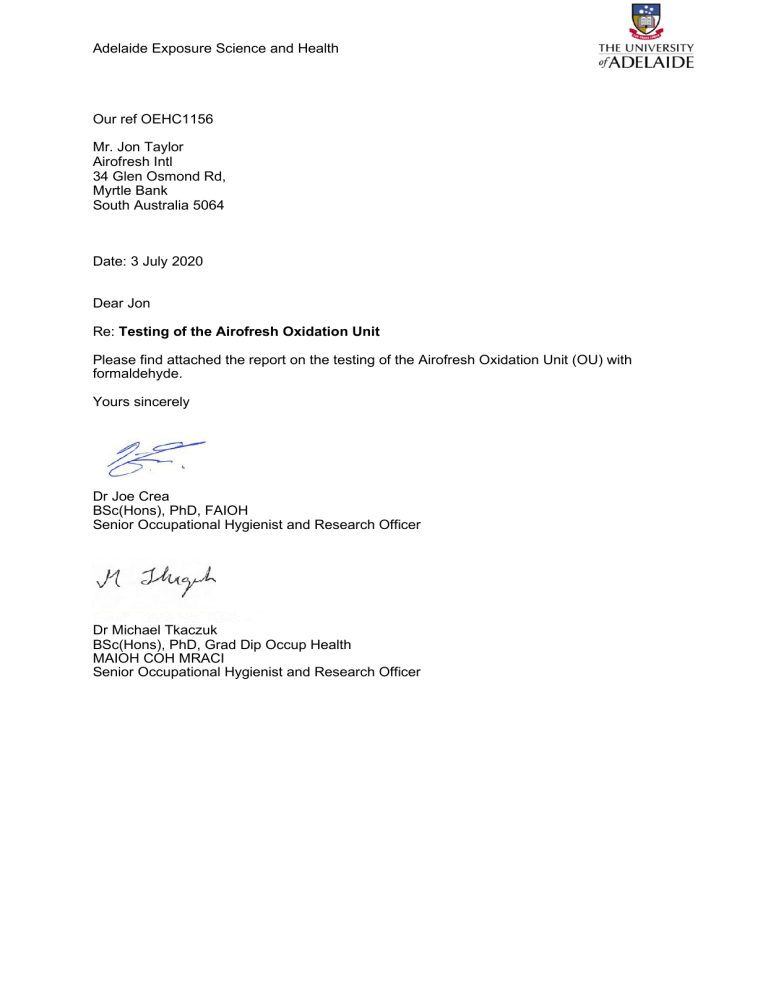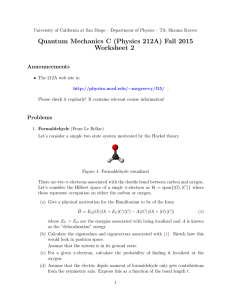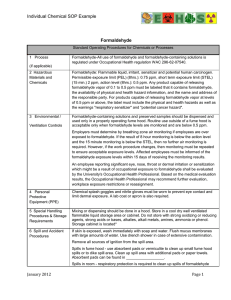
Adelaide Exposure Science and Health Our ref OEHC1156 Mr. Jon Taylor Airofresh Intl 34 Glen Osmond Rd, Myrtle Bank South Australia 5064 Date: 3 July 2020 Dear Jon Re: Testing of the Airofresh Oxidation Unit Please find attached the report on the testing of the Airofresh Oxidation Unit (OU) with formaldehyde. Yours sincerely Dr Joe Crea BSc(Hons), PhD, FAIOH Senior Occupational Hygienist and Research Officer Dr Michael Tkaczuk BSc(Hons), PhD, Grad Dip Occup Health MAIOH COH MRACI Senior Occupational Hygienist and Research Officer 1. PROJECT REVIEW DOCUMENT Testing Conditions for the Evaluation of Airofresh Oxidation Unit (OU) with Common Air Contaminants Dr, Joe Crea FAIOH, Dr Michael Tkaczuk MAIOH COH The University of Adelaide; School of Public Health, Faculty of Health and Medical Sciences Adelaide Exposure Science and Health Laboratory (formally Occupational & Environmental Hygiene Laboratory) The University of Adelaide, 28 Anderson Street THEBARTON SA 5031, Adelaide, Australia Duration of Research: February to June 2020 Research Report Date: 26 June 2020 SCOPE: The purpose of this study was to independently evaluate the performance of a n Airofresh Oxidation Unit (OU) on the removal of low concentrations of formaldehyde a in indoor environments. The test protocol was to create a realistic and standard environment as for Heating, Ventilation, and Air Conditioning (HVAC) setup requirements. The technology acceptance testing and validation was carried out in the environment for which the technology is intended to be used. Testing and analysis were undertaken by the Adelaide Exposure Science and Health Laboratory at The University of Adelaide has been impartial and subject to a systematic evidence-based assessment process. There are no competing or conflicting interests to declare. 2. TESTED AIR POLLUTANTS: • Formaldehyde: is commonly found in indoor air and has been used, as a component in building materials (e.g. particle board, furniture), adhesives and insulation materials. It is also used in the health care industry as a disinfectant and biocide and a tissue fixative and embalming agent. o 3. SYSTEM TEST CONDITIONS The unit tested was an Airofresh Oxidation Unit (AF1000 – see Figure 5) to determine the effectiveness of the removal of air contaminants is shown in Figure 1 operating at 240VAC The Airofresh Oxidative unit was placed in line using 200 mm diameter flexible HVAC ducting. The Airofresh Oxidative Unit was tested with the air flow operating at the pre-set motor velocity which was measured as 2.2 metres per second. Testing was carried out using low and high concentrations of the chosen air contaminant. The exhaust air from the in-line fan unit was fed into an operating Laboratory fume cupboard. The temperature and operating conditions have remained consistent throughout all experiments and test processes, that is the air temperature was 22oC, relative humidity 4050%, carbon dioxide concentration 500 - 600 ppm. Vapour/gas concentrations were collected/measured before (Pre) the unit and after (Post) the Airofresh Oxidative unit. Samples were collected inside the flexible ducts with the Unit operating with the air contaminant being present. Airflow: measured a 2.2 metres per second Temp 22 - 24oC; Relative Humidity 40- 50% Carbon Monoxide (CO concentration) < 0.1 ppm Carbon dioxide concentration CO2 500 – 600 ppm Guidance Data used to test formaldehyde The concentration range selected for this study used the following guidelines; ‘Safework Australia Workplace Exposure Standard for Airborne Contaminants’ and ‘NHMRC Goals for Maximum Permissible Levels of Pollutants in Indoor Air’. This document has been rescinded but not replaced by any Australian guideline. The recommended formaldehyde level in this guideline is 0.1 ppm. World Health Organisation (WHO) and the National Industrial Chemical Notification and Assessment Scheme (NICNAS) recommend a value of 0.08 ppm. The VOC recommendation by the rescinded NHMRC guideline is 0.5 mg/m3 The experimental limitations for determining the concentration range was the injection rate of the of the Syringe Pump (Figure 4) and the sample size of the air contaminant required for the analysis using High Pressure Liquid Chromatography (HPLC) for formaldehyde. Testing was done as a single pass continuous test. 4. MEASUREMENT OF AIR CONTAMINANTS For formaldehyde, a pre-weighed amount of para-formaldehyde was placed in an aluminium tray inside an insulated open-ended steel chamber with a glass wool filter over the end to stop any paraformaldehyde dust being released (Figure 3). The para-formaldehyde was heated using a heating block at set temperatures to be able to generate the required concentrations of formaldehyde in the flexible ducting. Samples of air were collected onto 2,4 dinitrophenyl hydrazine coated glass fibre filters connected to personal air sampling pumps set to 1.0 L/min flow rates to measure the concentration of formaldehyde vapour inside (at about the centre) the flexible duct (see Figure 1 for sample location). The analysis of the collected formaldehyde samples was carried out by a verified method for formaldehyde; ‘Health & Safety Executive (HSE), Method for determination of Aldehydes in air (MDHS 102)’ that utilises a high-performance Liquid Chromatography (HPLC) Ultraviolet (UV) analysis. The testing was carried out at room temperature (22oC to 24oC) and RH of 40% to 44% 5. RESULTS Formaldehyde Table 1 Airofresh Oxidative Unit testing with a variety of Formaldehyde concentrations Sampling Time (mins) 66 60 60 32 15 Concentration of formaldehyde generated Pre-Unit 0.009 0.017 0.020 0.049 0.374 Concentration of formaldehyde Post Unit 0.0039 0.0088 0.0120 0.0280 0.275 Efficiency of Unit removing formaldehyde 57 48 40 43 27 Comments ran at RT ran at RT ran at RT ran at RT heated to about 50oC 6. Discussion Testing of the Airofresh unit was carried by testing before (Pre) and after (Post) the Unit by generation concentrations of Formaldehyde. The concentrations generated were the lowest concentrations based on the settings of the Syringe pump unit and sensitivity of the analytical method. The concentrations generated were comparable to typical general environmental concentrations. The formaldehyde testing gave the largest reduction of 57% at the output of the Airofresh unit, at a generated formaldehyde concentration of 0.009 ppm, as seen in Table 1. From the table there is a trend of greater efficiency of the Airofresh unit as the generated concentration of formaldehyde decreases. Background formaldehyde concentrations in office environments in our experience, range from 0.002 ppm to 0.06 ppm. The Formaldehyde concentrations generated to test the Oxidative Unit is within the measured concentrations in office environments. Therefore, based on these results, it appears that no formaldehyde is generated and the background formaldehyde concentration in the laboratory is reduced Post the Oxidative Unit treatment. FIGURE1: Airofresh Oxidation Unit set up for testing Directionof airflow Sampling po int before unit Sampling po int after Unit Airofresh Unit FIGUR E5: AF 1000 Oxidation Unit with Serial Number FIGURE3: Formaldehyde vapour generation (heating paraformaldehyde on hotplate) FIGURE4: Syringe pump - used to automatically inject voc at known selected rates




